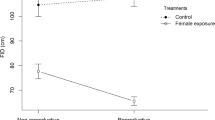Abstract
Because time spent in refuge may be costly if prey lose opportunities to forage, fight, or mate, prey allow predators to approach closer before beginning to flee when opportunity costs are high. Because the same opportunity costs may apply to refuge use as to escape, prey should make similar trade-offs between risk of emerging and cost of remaining in refuge. In the Iberian rock lizard, Lacerta monticola, we studied the effects of sex, reproductive season, speed of predator approach, and potential loss of mating opportunities on time spent in refuge following simulated predatory attacks. Lizards of both sexes adjusted refuge use to the level of risk by spending more time in refuge when approached rapidly than slowly. Females remained in refuge for equal times in the mating and postreproductive seasons, but males emerged sooner during the mating season, suggesting adjustment to a cost of lost opportunity to search for mates during the mating season. When a tethered female was nearby, males emerged from refuge earlier than if no female was present, indicating a trade-off between risk and mating opportunity. Approach speed affected emergence time when females were absent, but not when a female was present. Approach speed did not affect the probability that, after emerging, a male would return to court the female. For males that courted females intensely (bit them) before entering refuge, approach speed did not affect latency to emerge, but males that courted less intensely emerged sooner if approached slowly than rapidly. These findings show that males adjust the length of time spent in refuge to both risk of predation and reproductive cost of refuge use.


Similar content being viewed by others
References
Aragón P, López P, Martín J (2001) Seasonal changes in activity and spatial and social relationships of the Iberian rock-lizard Lacerta monticola. Can J Zool 79:1965–1971
Bonenfant M, Kramer DL (1996) The influence of distance to burrow on flight initiation distance in the woodchuck, Marmota monax. Behav Ecol 7:299–303
Burger J, Gochfeld M (1990) Risk discrimination of direct versus tangential approach by basking black iguanas (Ctenosaura similis): variation as a function of human exposure. J Comp Psychol 104:388–394
Burger J, Gochfeld M (1993) The importance of the human face in risk perception by black iguanas, Ctenosaura similis. J Herpetol 27:426–430
Candolin U (1997) Predation risk affects courtship and attractiveness of competing threespine stickleback males. Behav Ecol Sociobiol 41:81–87
Carrascal LM, López P, Martín J, Salvador A (1992) Basking and antipredator behaviour in high altitude lizard: implications of heat-exchange rate. Ethology 92:143–154
Clark CW (1994) Antipredator behaviour and the asset-protection principle. Behav Ecol 5:159–170
Cooper WE Jr (1985) Female residency and courtship intensity in a territorial lizard, Holbrookia propinqua. Amphibia-Reptilia 6:63–69
Cooper WE Jr (1997a) Factors affecting risk and cost of escape by the broad-headed skink (Eumeces laticeps): predator speed, directness of approach, and female presence. Herpetologica 53:464–474
Cooper WE Jr (1997b) Threat factors affecting antipredator behavior in the broad-headed skink (Eumeces laticeps): repeated approach, change in predator path, and predator's field of view. Copeia 1997:613–619
Cooper WE Jr (1998) Risk factors and emergence from refuge in the lizard Eumeces laticeps. Behaviour 135:1065–1076
Cooper WE Jr (1999) Tradeoffs between courtship, fighting, and antipredatory behavior by a lizard, Eumeces laticeps. Behav Ecol Sociobiol 47:54–59
Cooper WE Jr, Vitt LJ, Hedges R, Huey RB (1990) Locomotor impairment and defense in gravid lizards (Eumeces laticeps): behavioral shift in activity may offset costs of reproduction in an active forager. Behav Ecol Sociobiol 27:153–157
Crowley PH, Travers SE, Linton MC, Cohn SL, Sih A, Sargent RC (1991) Mate density, predation risk, and the seasonal sequence of mate choices: a dynamic game. Am Nat 137:567–596
Díaz-Uriarte R (1999) Anti-predator behaviour changes following an aggressive encounter in the lizard Tropidurus hispidus. Proc R Soc Lond B 266:2457–2464
Dill LM (1974) The escape response of the zebra danio (Brachydanio rerio). I. The stimulus for escape. Anim Behav 22:711–722
Dill LM, Fraser AHG (1997) The worm re-turns: hiding behavior of a tube-dwelling marine polychaete, Serpula vermicularis. Behav Ecol 8:186–193
Elvira B, Vigal CR (1985) Further data on the reproduction of Lacerta monticola cyreni (Sauria, Lacertidae) in Central Spain. Amphibia-Reptilia 6:173–179
Endler JA (1987) Predation, light intensity and courtship behavioour in Poecilia reticulata (Pisces: Poeciliidae). Evolution 29:151–158
Hazlett BA, Rittschof D (2000) Predation-reproduction conflict resolution in the hermit crab, Clibanarius vittatus. Ethology 106:811–818
Helfman GS (1986) Behavioral responses of prey fishes during predator-prey interactions. In: Feder ME, Lauder GV (eds) Predator-prey relationships. Princeton University Press, Princeton, NJ, pp 135–156
Koga T, Backwell PRY, Jennions MD, Christy JH (1998) Elevated predation risk changes mating behaviour and courtship in a fiddler crab. Proc R Soc Lond B 265:1385–1390
Koivula K, Rytkönen S, Orell M (1995) Hunger-dependency of hiding behaviour after a predator attack in dominant and subordinate willow tits. Ardea 83:97–404
Krupa JJ, Sih A (1998) Fishing spiders, green sunfish, and a stream-water strider: male-female conflict and prey responses to single versus multiple predator environment. Oecologia 117:258–265
Lima SL, Dill LM (1990) Behavioral decisions made under the risk of predation: a review and prospectus. Can J Zool 68:619–640
Magnhagen C (1990) Reproduction under predation risk in the sand goby, Pomatoschistus minutus, and the black goby, Gobius niger: the effect of age and longevity. Behav Ecol Sociobiol 26:331–335
Magnhagen C (1991) Predation risk as a cost of reproduction. Trends Ecol Evol 6:183–186
Martín J, López P (1996) The escape response of juvenile Psammodromus algirus lizards. J Comp Psychol 110:187–192
Martín J, López P (1999a) Nuptial coloration and mate guarding affect escape decisions of male lizards, Psammodromus algirus. Ethology 105:439–447
Martín J, López P (1999b) An experimental test of the costs of antipredatory refuge use in the wall lizard, Podarcis muralis. Oikos 84:499–505
Martín J, López P (1999c) When to come out from a refuge: risk-sensitive and state-dependent decisions in an alpine lizard. Behav Ecol 10:487–492
Martín J, López P (2000) Costs of refuge use affect escape decisions of iberian-rock lizards, Lacerta monticola. Ethology 106:483–492
Martín J, López P (2001) Repeated predatory attacks and multiple decisions to come out from a refuge in an alpine lizard. Behav Ecol 12:386–389
Martín J, Salvador A (1992) Tail loss consequences on habitat use by the Iberian rock lizard Lacerta monticola. Oikos 65:328–333
Martín J, Salvador A (1993) Thermoregulatory behaviour of rock-lizards in response to tail loss. Behaviour 124:123–136
Martín J, Salvador A (1997) Effects of tail loss on the time budgets, movements, and spacing patterns of Iberian rock lizards, Lacerta monticola. Herpetologica 53:117–125
McCloskey RT, Baia KA, Russell RW (1987) Defense of mates: a territory departure rule for male tree lizards following sex-ratio manipulation. Oecologia 73:28–31
Pérez-Mellado V, Gil MJ, Guerrero F, Pollo C, Rodríguez-Merino E, Marco A, Lizana M (1987) Uso del espacio y el tiempo en Lacerta monticola de la Sierra de Gredos. Graellsia 44:65–80
Ryan MJ, Tuttle MD, Rand AS (1982) Bat predation and sexual advertisment in a neotropical anuran. Am Nat 119:136–139
Shine R (1980) "Costs" of reproduction in reptiles. Oecologia 46:92–100
Sih A (1986) Antipredator responses and the perception of danger by mosquito larvae. Ecology 67:434–441
Sih A (1992) Prey uncertainty and the balancing of antipredator and foraging needs. Am Nat 139:1052–1069
Sih A (1997) To hide or not to hide? Refuge use in a fluctuating environment. Trends Ecol Evol 12:375–376
Sih A, Petranka JW, Kats LB (1988) The dynamics of prey refuge use: a model and tests with sunfish and salamander larvae. Am Nat 132:463–483
Sih A, Krupa J, Travers S (1990) An experimental study on the effects of predation risk and feeding regime on the mating behavior of the water strider, Gerris remigis. Am Nat 135:84–290
Sih A, Kats LB, Moore RD (1992) Effects of predatory sunfish on the density, drift and refuge use of stream salamander larvae. Ecology 73:1418–1430
Sokal RR, Rohlf FJ (1995) Biometry, 3rd edn. Freeman, New York
Stamps JA (1983) Sexual selection, sexual dimorphism and territoriality. In: Huey RB, Pianka ER, Schoener TW (eds) Lizard ecology: studies of a model organism. Harvard University Press, Cambridge, Mass, pp 169–204
Wolf NG, Kramer DL (1987) Use of cover and the need to breathe: the effects of hypoxia on vulnerability of dwarf gouramis to predatory snakeheads. Oecologia 73:127–132
Ydenberg RC, Dill LM (1986) The economics of fleeing from predators. Adv Stud Behav 16:229–249
Acknowledgements
We thank two anonymous reviewers for constructive and helpful comments, and "El Ventorrillo" MNCN Field Station for use of their facilities. Financial support was provided to J.M. and P.L. by the MCYT project BOS 2002-00547and to W.E.C. by an International Travel Grant from Purdue University. W.E.C. is grateful for logistical help by Valentín Pérez-Mellado. The experiments were performed under license from the Agencia del Medio Ambiente de la Comunidad de Madrid (Spain).
Author information
Authors and Affiliations
Corresponding author
Additional information
Communicated by A. Mathis
Rights and permissions
About this article
Cite this article
Martín, J., López, P. & Cooper, W.E. Loss of mating opportunities influences refuge use in the Iberian rock lizard, Lacerta monticola . Behav Ecol Sociobiol 54, 505–510 (2003). https://doi.org/10.1007/s00265-003-0659-3
Received:
Revised:
Accepted:
Published:
Issue Date:
DOI: https://doi.org/10.1007/s00265-003-0659-3




